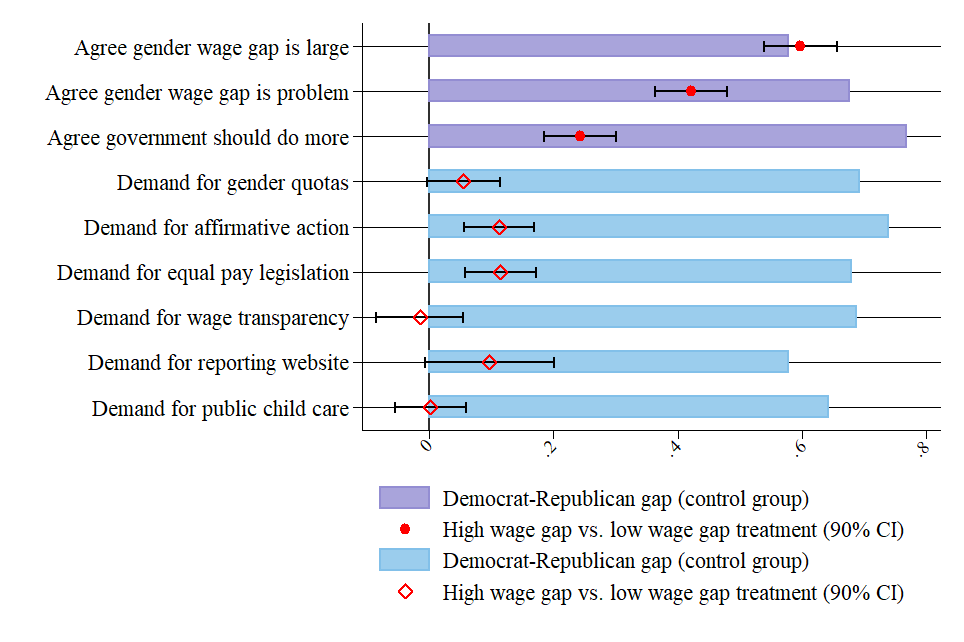Do beliefs about the gender wage gap affect policy views?
What beliefs do people hold about the size of the gender wage gap and factors influencing it? How do these beliefs differ across demographic groups? And to what extent do they influence people’s opinions on whether the government should support women in the labor market through policy-making? A recent paper by Sonja Settele answers these questions through an online survey experiment conducted in the US.
In a recent paper (Settele, forthcoming), I examine how beliefs about the size of the gender wage gap affect the demand for public policies aimed at supporting women in the labor market. If people have a distaste for inequality (Fehr and Schmidt, 1999), beliefs about the degree of gender-related wage inequality should determine the demand for government intervention aimed at mitigating this inequality. Indeed, the size of the gender wage gap is at the core of the public policy discussion (Umoh, 2016) and politicians as well as political activists regularly cite statistics about gender differences in wages. Expressed beliefs about wage disparities differ substantially across the political spectrum (Pew Research Center, 2017), and the fact that wages are often unobserved might help to sustain different beliefs across groups (Cullen and Perez-Truglia, 2020).
For this study, I ran an online survey experiment with a large sample that is representative of the adult US population. I first elicited the respondents' prior beliefs about a well-defined measure of females' relative wages, namely a woman's average income for every $100 made by a man when both are 45-year-old employees, hold a Bachelor's degree and work 40 hours per week on average. Next, I generated exogenous variation in beliefs about the size of the wage gap via two randomly assigned information treatments, based on recent data from two official household surveys ran by the US Census Bureau. The two surveys yielded different estimates of the above wage statistic due to sampling variation and procedural differences. Specifically, participants exposed to a “high wage gap" treatment learned that a female's wage amounts to 74 percent of a male's wage, on average, when both hold the previously described characteristics. Those assigned to a “low wage gap" treatment, in contrast, learned that the corresponding wage statistic amounts to 94 percent. Subsequently, I elicited the respondents' demand for policies that are supportive of women in the labor market.
Based on this experimental design, I found the following:
First, people's prior beliefs about women's relative wages are highly dispersed, with Republicans and men holding more optimistic beliefs than Democrats and women. Moreover, in the control group, that does not receive any information, women, Democrats and individuals who believe that the wage gap is larger are more in favor of policies aimed at supporting women in the labor market.
Second, beliefs about the size of the gender wage gap have a strong causal effect on people's sense of concern and unspecific policy demand. The effect of these beliefs on demand for concrete policies is meaningful but more nuanced, i.e., it depends on the specific policy (see Figure 1).

Note: All outcomes are standardized based on the mean and standard deviation in the control group. The bars illustrate the raw differences between Democrats and Republicans in the control group. The point estimates represent the treatment effect (i.e. the difference in outcomes between the “high wage gap” and the “low wage gap” treatment).
A back-of-the envelope calculation suggests that differences in beliefs across the political spectrum causally explain between zero and at most 6 percent of the partisan difference in demand for specific policies. Similarly, gender differences in beliefs causally explain up to 7 percent of the gender difference in policy demand.
In addition, I find that the low average elasticity of policy demand to beliefs about the size of the wage gap is not due to respondents attributing the wage gap to “fair” reasons. In fact, respondents causally attribute the gender wage gap to arguably unfair factors such as gender-based discrimination in labor markets. Moreover, I can rule out a zero or backfiring effect among men based on self-interest. Instead, the elasticity of policy demand to beliefs is limited by Republicans, by a substantial subset of individuals who do not believe that policies can effectively lead to an increase in women's relative wages, and by those with extreme beliefs to start with, who may be more “dogmatic” in their policy views.
Finally, additional evidence suggests that people find ways to adjust their beliefs about the gender wage gap in line with their policy views. Specifically, people selectively acquire information in line with their policy preferences, which may explain persistent and systematic differences in beliefs. In addition, there is evidence of politically motivated bias in reported beliefs about the size of the wage gap across genders, but not by partisan affiliation.
You can hear Sonja Settele explain about about the findings in the video below:
For more details, have a look at the paper here.
References
Cullen, Zoë B., and Ricardo Perez-Truglia. 2020 “The salary taboo: Privacy norms and the diffusion of information.” Working Paper.
Fehr, Ernst, and Klaus M. Schmidt. 1999 "A theory of fairness, competition, and cooperation." The Quarterly Journal of Economics 114.3: 817-868.
Gallup Social & Policy Issues. 2016. “Fewer in U.S. say men and women have equal job opportunities.” Online article: https://news.gallup.com/poll/194036/fewer-say-men-women-equal-job-opportunities.aspx [Accessed: 16.03.2019].
Pew Research Center. 2017. “Wide partisan gaps in U.S. over how far the country has come on gender equality." Online article: https://www.pewresearch.org/social-trends/2017/10/18/wide-partisan-gaps-in-u-s-over-how-far-the-country-has-come-on-gender-equality/ [Accessed: 16.03.2019].
Settele, Sonja. forthcoming "How Do Beliefs About the Gender Wage Gap Affect the Demand for Public Policy?". American Economic Journal: Economic Policy.
Umoh, Ruth. 2016. “How to convince a skeptic the pay gap is real." Online article: https://www.cnbc.com/2018/04/10/6-ways-to-convince-a-skeptic-the-pay-gap-is-real.html [Accessed: 16.03.2019].
